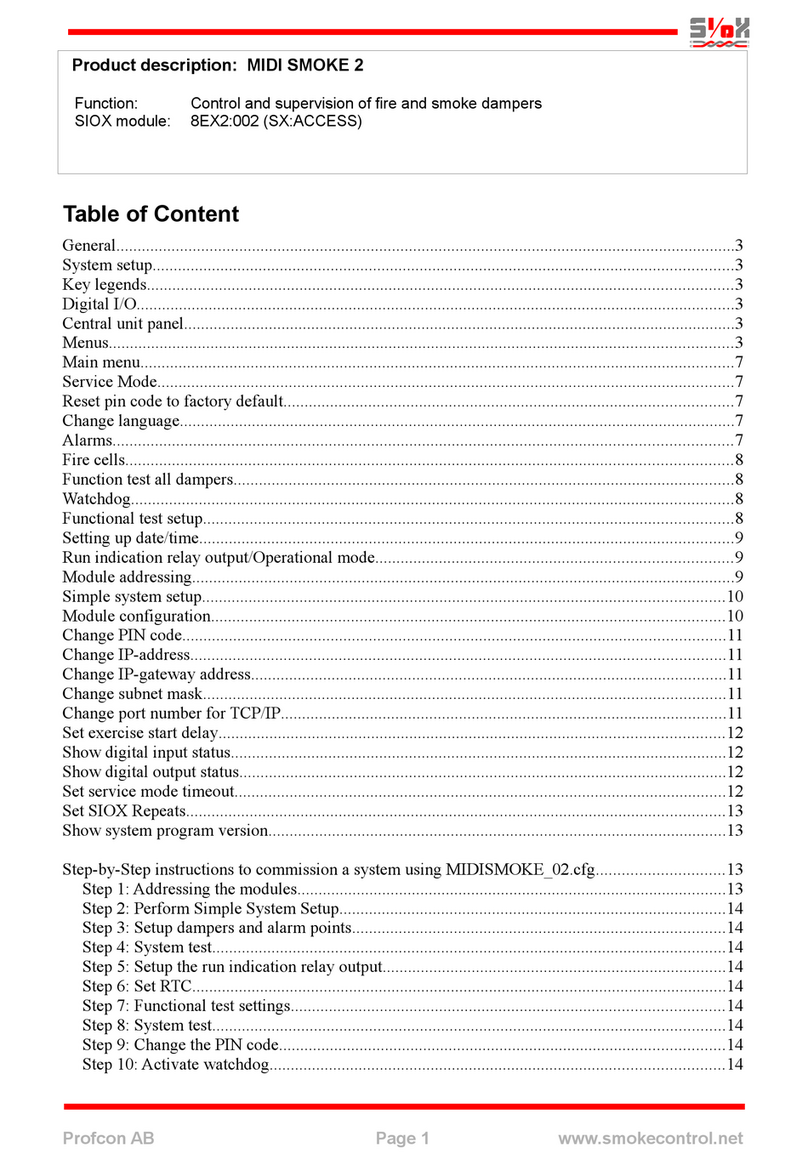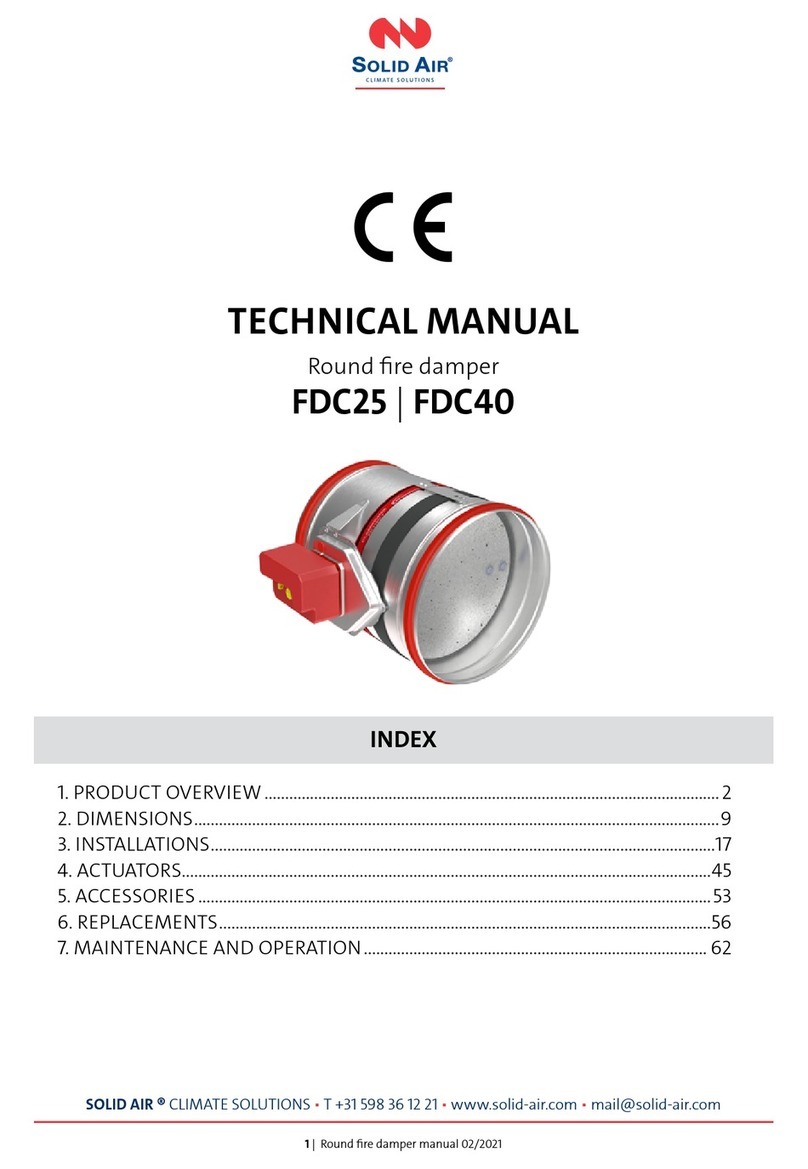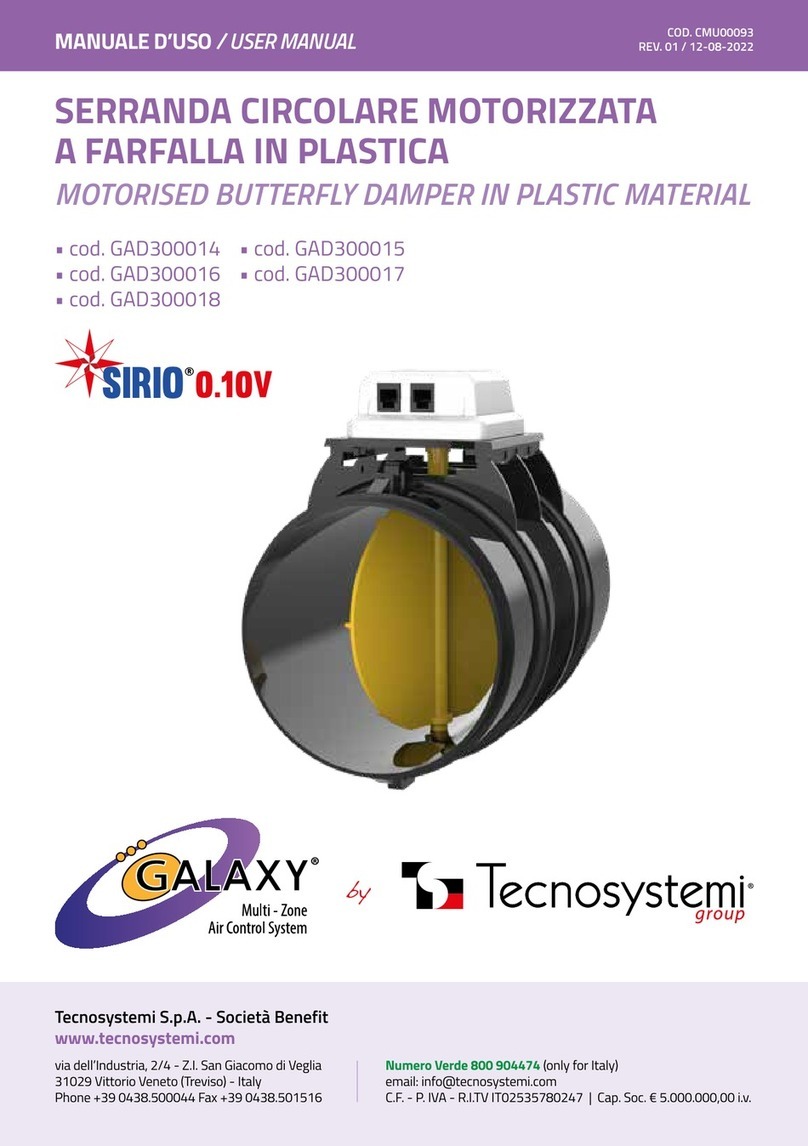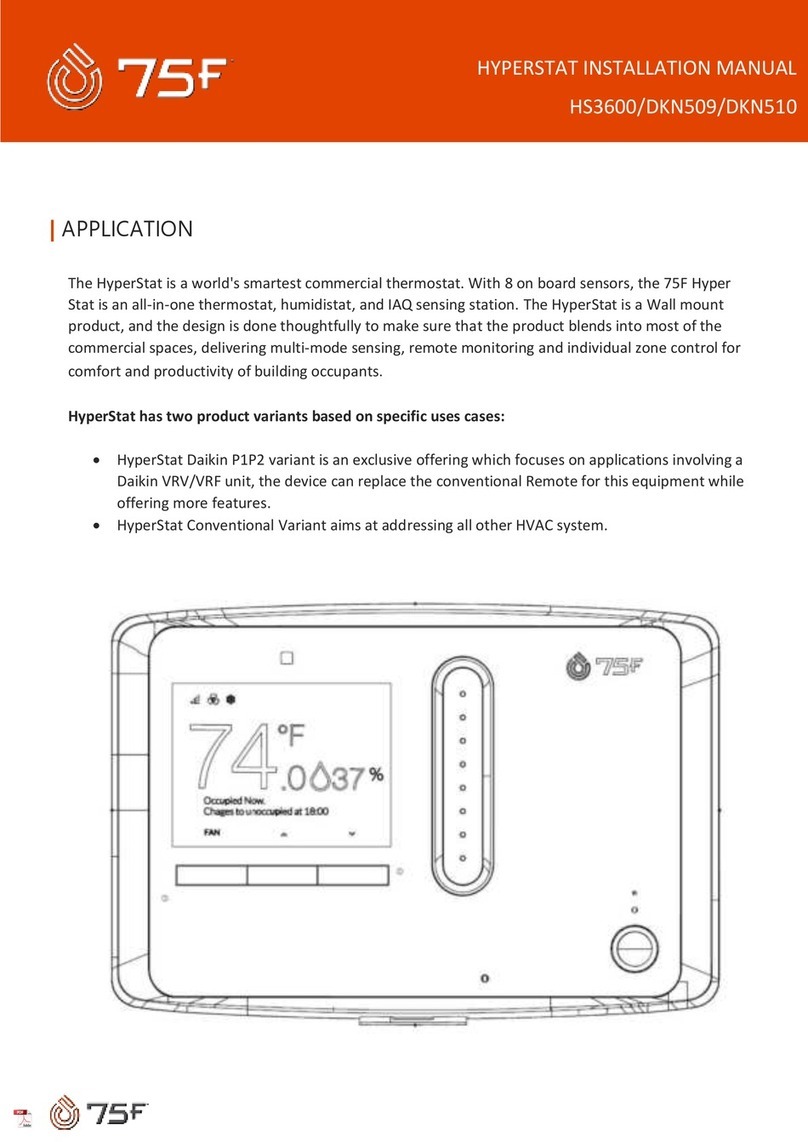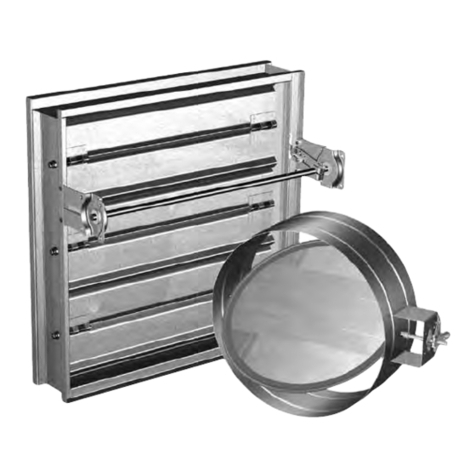Belimo FS Series User manual

INSTRUCTION SHEET Replacement of Multiproducts motors with Belimo FSxx Series
1
INSTRUCTION SHEET
Replacement of MultiProducts motors
to Belimo FSxx Series
Contents
UL®...............................................................................................................................2
Code and Standard Issues...........................................................................................2
NFPA 80 (Fire) & NFPA 105 (Smoke) .........................................................................3
Local Code Approval....................................................................................................4
Cross Reference ..........................................................................................................5
Typical Multiproducts Replacement Concept...............................................................6
Examples of Multiproducts installations.......................................................................7
Shaft Springs and Fusible Links...................................................................................9
McCabe®Link Bimetal................................................................................................10
Negator Spring Applications – Ruskin and Air Balance.............................................11
Completed Installations..............................................................................................12
Special Mounting........................................................................................................13
Instructions.................................................................................................................13
Wiring.........................................................................................................................15
Fire Marshal / Building Official Notification Form.......................................................18
Contacts:
East Coast 800 543-9038 x3119 West Coast 800 987-9042 x 2458
Aaron Nobel 203 749-3119 Jeremy English 775 355-2458
Mike Knipple 203 749-3170 Larry Felker 775 355-2461
WARNING!
Installer must be trained and experienced with repair
of fire and smoke dampers and actuators.
WARNING!
Before replacing actuator, damper must be inspected and
determined to be fully functional. See damper checklist in NFPA 80 &
NFPA 105 sections.

INSTRUCTION SHEET Replacement of Multiproducts motors with Belimo FSxx Series
2
UL®
Code and Standard Issues
In general, the administrative section of codes state that all mechanical and electrical systems
must be kept in working order and an individual section may state that all life safety devices and
systems must be operable. NFPA 80 (Fire) & NFPA 105 (Smoke) require periodic testing and
repair of dampers as soon as possible after any deficiency is uncovered.
Fire & smoke dampers are considered to be appliances and field replacement of components is to
be expected when failure of any component occurs.
The Authority Having Jurisdiction (local Fire Marshal and/or Building Official) must be consulted if
any blade or auxiliary switches are employed and are connected to the fire alarm system or to a
Fire Fighters Control System. A permit and inspection may be required since connections to an
alarm system have been touched.
In the “Marking & Application Guide, Dampers for Fire Barrier and Smoke
Applications & Ceiling Dampers” April 2003 by Underwriters Laboratories
Inc.®, page 6 they state:
DAMPER ACTUATORS
“… field mounting or substitution of actuators is not covered within the scope
of the UL certification of the product. However, this does not necessarily
preclude replacement of actuators in the field. Like any appliance, field
servicing of these products is not covered under the scope of the UL
certification and factory follow-up service program. As with any part of the
damper, it is expected that replacement of actuators in the field be done in
accordance with the damper manufacture’s normal field servicing program.”
This document follows the UL requirements and the acceptance testing
that is necessary to ensure proper operation of a fire and smoke damper after
actuator replacement.

INSTRUCTION SHEET Replacement of Multiproducts motors with Belimo FSxx Series
3
NFPA 80 (Fire) & NFPA 105 (Smoke)
See NFPA 80 & NFPA 105 for details. The damper cleaning and examination check
list here is based on them.
Damper installation shall meet code requirements. Fire stopping and drywall integrity shall be
confirmed. Damper blades shall be in plane of wall. Duct shall be fall away with no fasteners
connected to damper sleeve.
a. Dampers and ducts shall be cleaned of all foreign debris and dust build-up.
b. All exposed moving parts of the damper shall be dry lubricated as required by the
manufacturer. Do not use oil as it draws dirt.
c. Damper shall be examined without defective old motor or new actuator to determine:
i. The damper shall fully close from the open position.
ii. Damper shall fully open from the closed position.
iii. There are no obstructions to the operation of the damper. The damper shall not be
blocked from closure in any way due to rusted, bent, misaligned, or damaged frame
or blades. The damper shall not have defective hinges, side &/or blade seals, or
other moving parts. The damper frame shall not be penetrated by any foreign
objects that would affect operation.
d. If the damper is equipped with a fusible link, the link shall be removed for testing to ensure
full closure and lock-in-place if so equipped. If the link is damaged or painted, it shall be
replaced with a link of the same size, temperature, and load rating.
e. The fusible link shall be reinstalled after testing is complete.
After installation and wiring of new actuator it shall be tested.
a. The checklist may be customized using material here and in NFPA Standards. Multiple
geometric configurations of springs, fusible link, thermal sensor(s), and actuation are possible.
Confirm with AHJ if any additional requirements exist.
b. Electric thermal sensors, if present, must be tested and replaced if defective.
c. The test shall be conducted with normal HVAC airflow.
d. When equipped with smoke detection activation, the smoke detector shall be activated
and damper operation observed.
A record of all repairs must be kept and made available to AHJ.
NFPA requires damper inspection and repair of dampers.
See www.nfpa.org. for Standards.
Test voltage input to actuators and repair as necessary if voltage is not correct.
Old breakers often deliver below 115V and failed actuators may be due to power
supply problems.

INSTRUCTION SHEET Replacement of Multiproducts motors with Belimo FSxx Series
4
Local Code Approval
While it is not detailed in codes, the following rules should be followed for selecting Belimo
actuators for replacement:
Check the technical specifications to ensure an “equal or better” actuator is used.
Temperature – the replacement actuator shall have been UL555S tested at the same or
better temperature as the original actuator. 250˚F or 350˚F are standard.
Time – the replacement actuator shall drive open and spring closed at a speed equal or
faster than presently required by codes. (The AHJ may grant an exception and
“grandfather” slower actuators where the original actuator was slower.)
Torque – replacement actuator shall have equal or greater torque than the failed
actuator.
Voltage – replacement actuator shall have the same voltage rating as the original.
Amperage – the replacement actuator(s) shall not draw more amperage than the
original(s) and cause the total connected amp draw on a circuit breaker to be greater
than allowed by electrical code.
Final Testing – actuated damper and associated devices shall be tested for proper
operation. See Acceptance testing details below.
(Mnemonic device: TTT-VAT)
WARNING!
In all cases, installation must comply with any and all local electrical
and life safety codes. Operation of the system after installation must
be performed to verify proper damper cycling. Final checkout requires
verifying correct function.
WARNING!
Note that where any fire alarm wiring is touched, the fire department
must be informed.

INSTRUCTION SHEET Replacement of Multiproducts motors with Belimo FSxx Series
5
Cross Reference
One is not replacing the Multiproducts motor itself, but rather installing a new actuator
on the damper shaft. In most cases the new installation is the same as the modern
UL555S listed method. There were many models of Multiproducts used and no
complete cross reference exists. Some are listed below. Most were 120V, but verifying
voltage is necessary.
Among the models that the FSLF120 replaces are the 2781 (Ruskin), 2985E (120V
Greenheck), 3159 (Air Balance), 5953, 5949, M12, 6347, and 5186. The 2986A (24V) is
replaced by the FSLF24.
A general rule of thumb is that the FSLF replaces motors on dampers 3 sq.ft. and
smaller and the FSNF replaces motors on dampers greater than 3 sq.ft. The Belimo
FSLF has passed UL555S testing at larger sizes; however, with age and corrosion, it is
best to be conservative. Call if questions exist.
The Multiproducts motors varied in torque, CW or CCW rotation, length of shaft, shaft
shape, electrical mounting, and voltage. All of these except voltage may be ignored with
focus on the damper itself.
It is technically superior to remove the old motor and replace using the methods
shown below. This also produces an installation that is closest to the present UL
mounting methods.
THERE ARE A LARGE NUMBER OF DIFFERENT MULTIPRODUCTS
MOTORS AND APPROACHES TO SPRING RETURN. CALL BELIMO
FOR ANY NOT COVERED HERE.
* More important than the torque rating is the
damper manufacturers’ UL555S testing.
Each manufacturer tests Belimo separately
and has different sizes UL555S listed.
NOTE. Although an actuator may pass a
larger sized damper use the UL listed sizing.
See www.belimo.us/firesmoke for a cross
reference by manufacturer.

INSTRUCTION SHEET Replacement of Multiproducts motors with Belimo FSxx Series
6
Typical Multiproducts Replacement Concept
After removing the
extraneous parts, the
damper shaft is available
for direct coupling.
Note that the old motor
has been left in this case
as it provides a good
base for the Belimo anti-
rotation strap.
The Belimo is
mounted on the shaft
with no linkages or
external spring.
Test by cycling
and tripping thermal
sensor. Reset and
completed.

E
xa
Bla
c
INSTRUC
T
a
mples
o
c
k arrow p
o
T
ION SHEET
f Multipr
o
o
ints to th
e
Replace
m
o
ducts i
n
e
spring.
W
m
ent of Multi
p
n
stallatio
n
W
hite arro
w
p
roducts mot
o
n
s
w
points t
o
o
rs with Beli
m
o
the dam
p
m
o FSxx Seri
e
p
er shaft.
e
s 7

INSTRUCTION SHEET Replacement of Multiproducts motors with Belimo FSxx Series
8
The two pictures above show views of an external “screen door” spring return
application. The spring is missing on the left application. As with the other examples
above, remove the old motor, linkage and spring. Mount the Belimo over the shaft.
Other examples are shown above. The arrow points at the spring in the right
photograph. It is removed along with the motor.
Unless the Building Official or Fire Marshal
specifically approves motor replacement,
the damper should be replaced. The cut
drywall violates the code as it impairs the
fire protection. REPLACE DAMPER.
EMB2X Multiproducts
type motor. A number
of variations were
made.

INSTRUCTION SHEET Replacement of Multiproducts motors with Belimo FSxx Series
9
In above examples, the extraneous parts are removed and the Belimo dropped onto the
damper shaft.
Shaft Springs and Fusible Links
In the examples below there is a spring wrapped around the damper shaft
with a fusible link holding it (arrows). The link prevents the spring from
slamming the damper blades closed. When it melts at 165°F the spring is
released.
This is the fire damper function.

INSTRUCTION SHEET Replacement of Multiproducts motors with Belimo FSxx Series
10
McCabe®Link Bimetal
The shaft spring and
fusible link (arrow) are
NOT to be removed or
modified.
If the fusible link melts due to
temperatures over 165°F the
shaft spring slams the damper
closed.
This is the fire function.
Jackshaft
Spring
McCabe
®Link
Bimetal Motor Arm
Engaged in
Link
Top. A full Belimo instruction for
the McCabe link dampers can
be found at
www.belimo.us/firesmoke
Bottom. As with most of this type
of application, remove the motor,
spring, cable, and linkage.
Mount Belimo and wire per
drawings found below.

INSTRUCTION SHEET Replacement of Multiproducts motors with Belimo FSxx Series
11
Negator Spring Applications – Ruskin and Air Balance
This application is different from all the others. The springs are attached to the damper
blades and instead of a fusible link, there is a fusible rod that connects the blades to the
motor. Replacement rods are available, but the springs are typically broken or missing.
If they are intact then a kit is available from Ruskin. See below.
If the springs are not intact, then the rod can be replaced with ones made by a
machine shop. A Belimo BAE 165 US sensor can be installed. This upgrades the
damper to modern standards. Call for information.
Ruskin makes a kit with a shaft
adaptor, hold down, and Belimo
FSLF120 actuator.
Replacement fusible rods are also
available in two lengths.
Where the springs are defective
solid rods, a BAE 165 US sensor,
and rewiring are necessary.
See MP2781 Installation Instruction
.

INSTRUCTION SHEET Replacement of Multiproducts motors with Belimo FSxx Series
12
Completed Installations
FSLF (left) or FSNF
(right) mounted on
the damper shaft.
Two sheet metal
screws hold the anti-
rotation strap. Two
nuts secure cold-weld
clamp onto shaft.

INSTRUCTION SHEET Replacement of Multiproducts motors with Belimo FSxx Series
13
Special Mounting
Depending on the geometry, any number of mounting arrangements are correct.
The most common are shown here.
Alternately, the anti-rotation strap can be attached to any Belimo linkage, an
electrical J-box cover plate, or to a pieced of U-channel.
It is important to remember that the ducts are fall-away. The actuator mounting
cannot interfere with the ability of the duct to fall from the damper. The damper must
continue to protect the wall.
See Belimo Mounting Methods Guide for more mounting drawings at
www.belimo.us in the documentation tab.
Instructions
An FSLF120 has sufficient torque to handle almost any damper that had a Multiproducts
motor. Only if a leg kit is required should an FSNF120 be used. In some cases where
the Multiproducts had insufficient torque initially, the FSNF is preferred.
1. Disconnect power to damper.
2. Disconnect wiring from motor to thermal sensor wiring box if present.
3. Remove spring, linkage parts, and motor from damper.
4. Test damper to ensure it moves easily from open to closed and back again.
Clean, lubricate (food grade silicone spray or equal – NOT WD40).
5. The Belimo is slightly wider than the old MultiProducts. If the Belimo does not fit
in the space available, then any thermal sensor sheet metal enclosure can be
removed and a 4” x 2” electrical box with open back installed. The box covers
the thermal sensors. This is typically necessary on small dampers.
6. Most applications had shaft springs and fusible links. Some had modern
electrical thermal sensors. See drawings. Negator spring, internal pully, or other

INSTRUCTION SHEET Replacement of Multiproducts motors with Belimo FSxx Series
14
irregular arrangements do exist. Some are field modifications. Take
photographs and send to Belimo for analysis.
NOTE:
If the damper shaft bearing does not hold the shaft firmly, then a Belimo FSNF
should be used with a leg kit, ZG-AF. The actuator then serves to hold the jackshaft
steady. On small dampers, it may be necessary to extend a flat plate out in the air in
order to mount leg kit.
7. Check direction of rotation of damper and jackshaft. Place clamp of Belimo
FSLF120 on CW or CCW side as necessary.
8. Place Belimo FSLF120 onto the shaft.
9. At this point, any jackshaft drive blade bracket connecting bar closer to blade
axle will need to be adjusted.
10.90 to 95 degrees of jackshaft rotation must be 90 degrees of blade rotation.
11. Actuator rotates 95 degrees and this must achieve full closed and near open.
Typically 93 degrees of actuator rotation gives 90 degrees of damper rotation
after adjusting.
12. Mount anti-rotation bracket of Belimo to sleeve.
13. Tighten clamp nuts.
14. Wire actuator per drawings below.
15. Cycle 3 times to insure proper cycling. If not perfect, readjust linkage, flip
actuator over, or troubleshoot to identify problem.
16. Thermal sensor must be checked with heat gun to ensure it opens upon
detection of heat. See Fire Marshal form for steps with single and dual
sensors. If sensor is defective, replacements must be obtained from local
damper manufacturer rep.
17. Press manual reset and cycle again to ensure operation.
18. Fill out Fire Marshal form on last page of instructions.
Note that actuator floats freely. Clamp cold welds when teeth dig into the damper shaft and the
anti-rotation strap stud allows the actuator to move if shaft is not perfectly concentric. Rigid
mounting by jamming the stud into the U-slot of actuator is NOT usually best.
WARNING!
USE CAUTION!
Spring is under high torsion and may cause serious injury! If any external
springs are present, exercise caution – wear face and hand protection.

INSTRUCTION SHEET Replacement of Multiproducts motors with Belimo FSxx Series
15
Wiring
There are three wiring schemes that describe all applications. While the geometry of the wire
runs may vary, the connections are straightforward.
Regardless of the wiring routes used, this drawing shows the wiring necessary for a UL555S
damper and actuator. Use it as a basis for any of the other wiring schematics. Note that the
alarm connections are not touched when replacing an actuator. This is a major concern for Fire
Marshals.
WARNING!
Read Data Sheet provided in box with each actuator for specific wiring details.
WARNING!
Disconnect and lock out power before starting to disconnect old motor.
WARNING!
Actuator anti-rotation strap may not be screwed to the duct. It must attach to
either the sleeve or to the mounting bracket. The duct must be able to fall away
from the damper in case of ceiling collapse in a fire.

INSTRUCTION SHEET Replacement of Multiproducts motors with Belimo FSxx Series
16
HOT
120 or
24 VAC
TYPICAL COMBINATION FIRE-SMOKE DAMPER WIRING
165°F
Smoke Detector or Relay from area
smoke detection system
BELIMO
FSxx
ACTUATOR
TYPICAL SENSOR
TEMPERATURE
N or
COM
Electric thermal disc
To alarm
system
If more wiring space
is required, a j-box
can be attached to
the actuator with a
chase nipple and
locknut.

INSTRUCTION SHEET Replacement of Multiproducts motors with Belimo FSxx Series
17
Notes:
In rare cases the motor was installed as a retrofit on dampers with fusible
links. There is no electric sensor in the damper in that case as there is
typically a shaft spring performing the fire function. Wiring is shown to right.

INSTRUCTION SHEET Replacement of Multiproducts motors with Belimo FSxx Series
18
Building Official / Fire Marshal Notification Form
Retain this portion of checklist at premises for Fire Marshal inspection. See local AHJ or Fire Marshal for
other information and requirements regarding conformance with NFPA 80 & NFPA 105.
Test Checklist (Smoke dampers do not have sensors. Only steps a & b apply.)
1. Single Sensor Combination Damper
a. Open smoke detector or relay wire or contact to cut power. Damper springs closed.
b. Reconnect power. Damper drives open.
c. Open thermal sensor using heat gun. Damper springs closed.
d. Press thermal sensor manual reset. Damper drives open.
Repeat 3 times to ensure operation. This imitates UL555S test.
2. Reopenable Two Sensor Fire-Smoke Combination Damper
(Since this system involves the Firefighters’ Smoke Control System, inform fire department.)
With FSCS switch in Auto position:
a. Disconnect power from smoke detector or relay contacts. Actuator springs damper closed.
b. Reconnect power. Actuator drives damper open.
c. Trip thermal sensor. Actuator springs damper fully closed.
d. Press manual reset. Actuator drives damper open.
Test FSCS switch functions:
a. Move FSCS switch to Off position. Actuator springs damper fully closed.
b. Move FSCS switch to Hand position. Actuator drives damper open.
c. Trip secondary (higher temperature) thermal sensor. Actuator springs damper fully closed.
d. Press manual reset of secondary sensor. Actuator drives damper open.
Move FSCS switch back to Auto position:
a. Actuator springs damper closed if Primary sensor is still open.
b. Actuator stays open if Primary sensor has re-closed.
When completed, ensure sensors are reset and smoke detector is in normal state and FSCS
switch is in Auto. Damper is normally Open; check sequence of operation.
Damper Numbers or Location Identifying Numbers..………………………………………………………
Date……-…………-..……
Contractor……………………………………………………………………………………………………….
Service Technician (Print)……………..………………………………………………………………………
Service Technician (Signed)……………..……………………………………………………………………
Phone Number (……)………………………………………………
Notes…….………………………………………………………………………………………………………
……………..…………………………………………………………………………………………………….
……………...……………………………………………………………………………………………………
Other manuals for FS Series
4
Table of contents
Popular Fire And Smoke Damper manuals by other brands
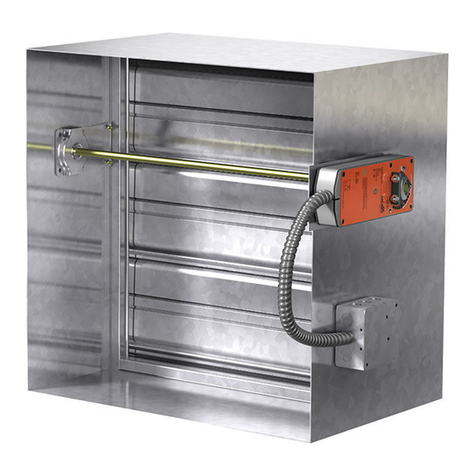
Greenheck
Greenheck FSD Series Installation, operation and maintenance manual
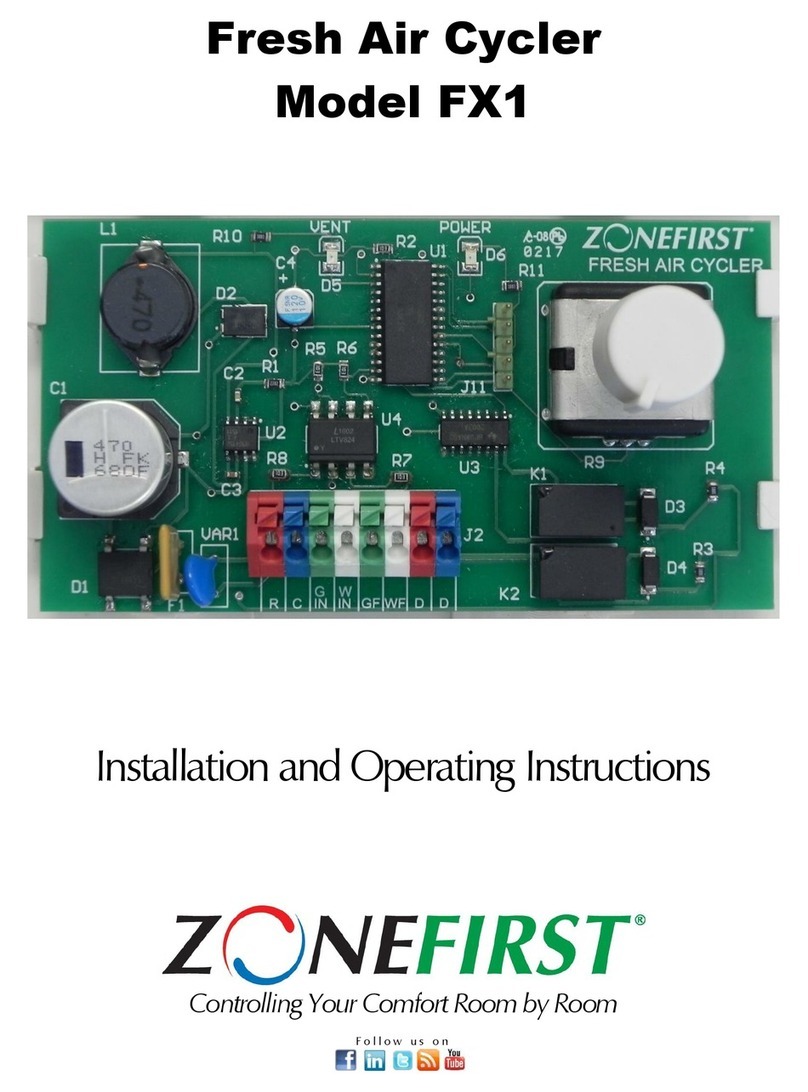
Zonefirst
Zonefirst Fresh Air Cycler FX1 Installation and operating instructions
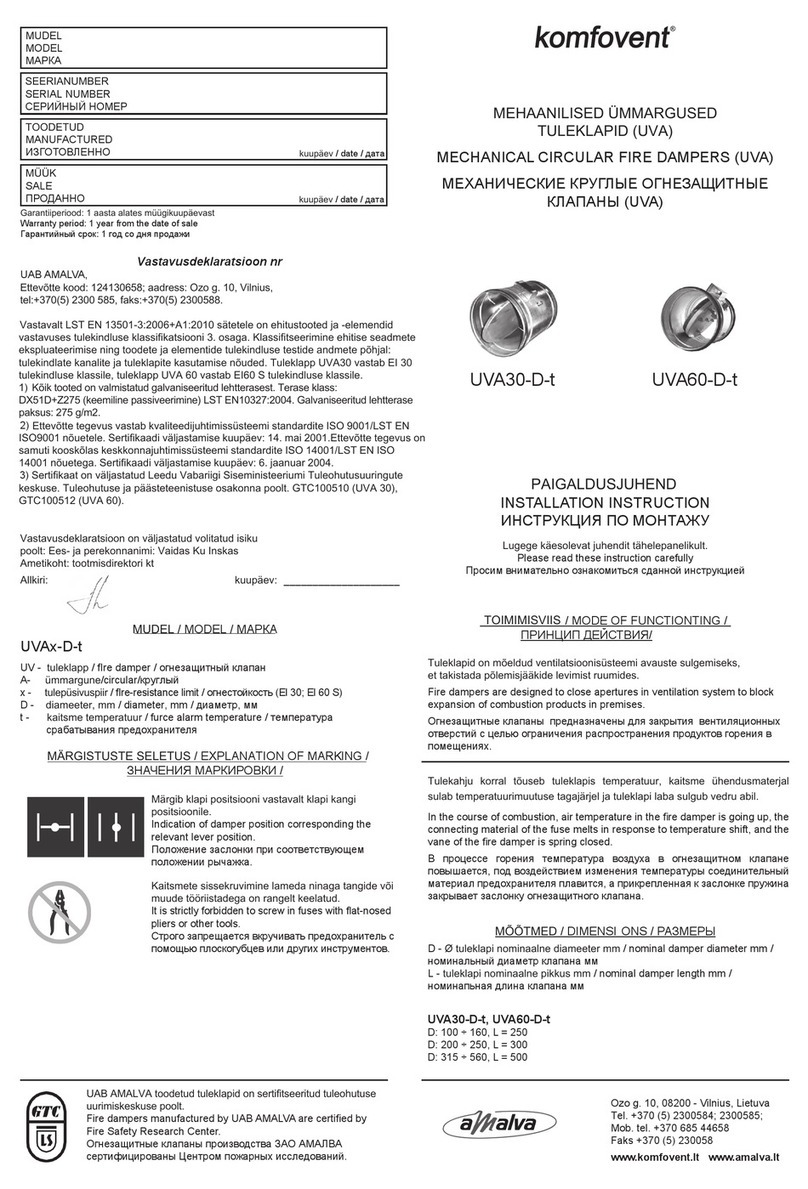
Komfovent
Komfovent UVA30-D-t installation instructions

actionair
actionair SmokeShield Installation Methods

Mandik
Mandik NKTM manual
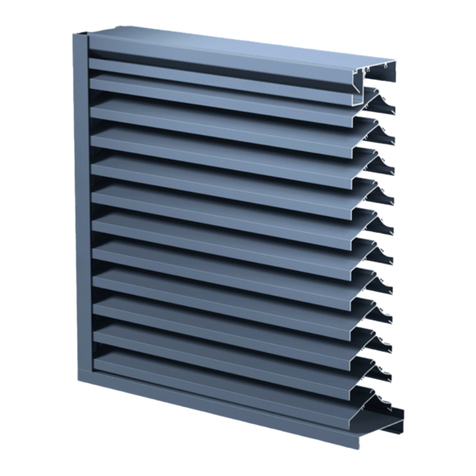
Greenheck
Greenheck EHM-601 Installation, operation and maintenance manual
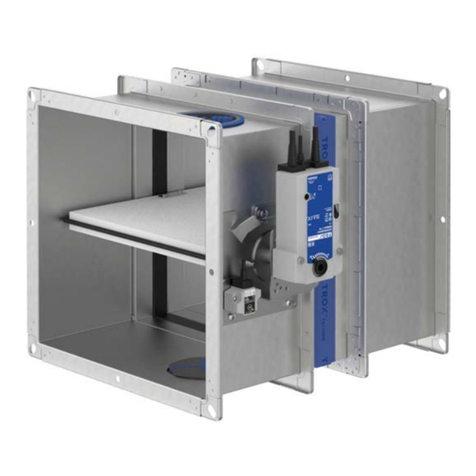
Trox Technik
Trox Technik FK2-EU Installation and operating manual
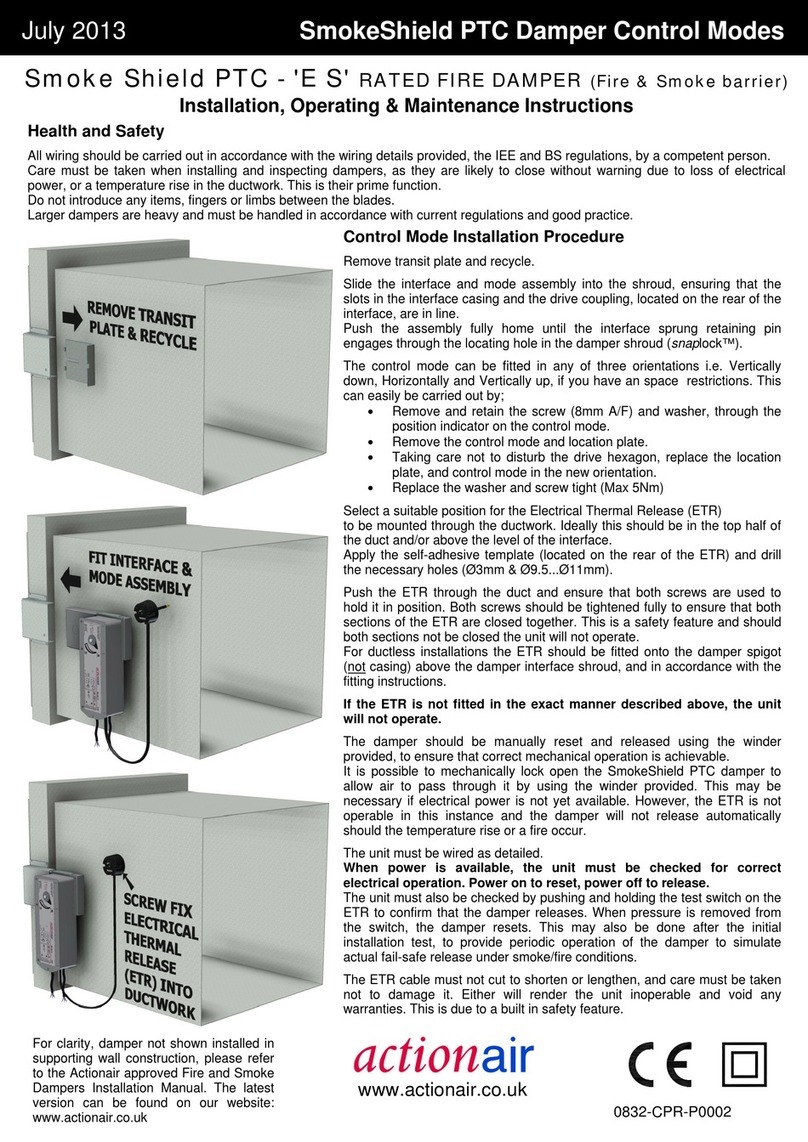
actionair
actionair SmokeShield PTC Installation, operating, & maintenance instructions
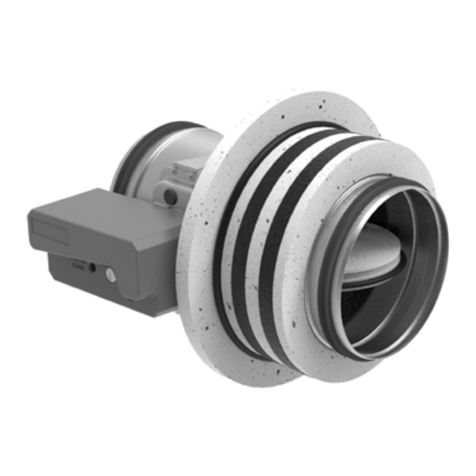
SOLID AIR
SOLID AIR FDC25 Technical manual

Stuv
Stuv AW1200100300 installation manual
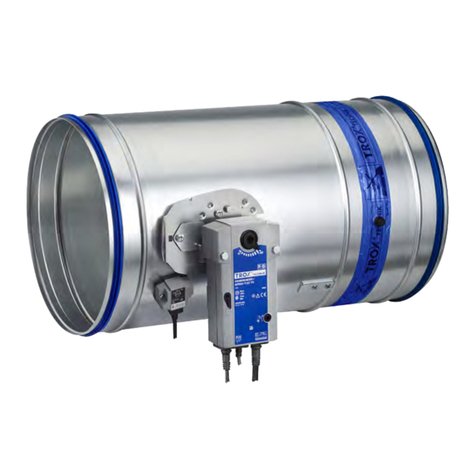
Trox Technik
Trox Technik FKR-EU Installation and operating manual
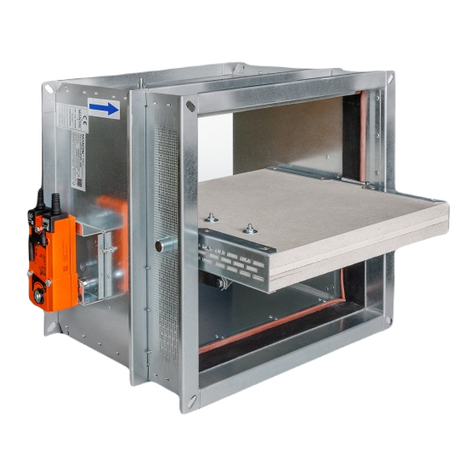
Mandik
Mandik MSD Technical documentation
